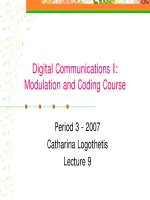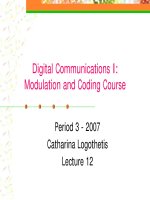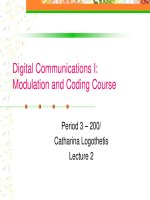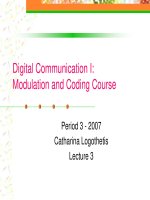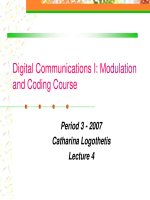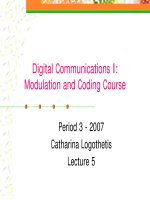vlsi design course lecture notes ch12
Bạn đang xem bản rút gọn của tài liệu. Xem và tải ngay bản đầy đủ của tài liệu tại đây (536.39 KB, 34 trang )
ECE 410, Prof. A. Mason Lecture Notes 12.1
Binary Adder
• Binary Addition
– single bit addition
– sum of 2 binary numbers can be larger than either number
– need a “carry-out” to store the overflow
• Half-Adder
– 2 inputs (x and y) and 2 outputs (sum and carry)
x y x + y (binary sum)
0 + 0 = 0
0 + 1 = 1
1 + 0 = 1
1 + 1 = 10 (binary, i.e. 2 in base-10)
x y s c
0 0 0 0
0 1 1 0
1 0 1 0
1 1 0 1
s = x ⊕ y
c = x • y
XOR
AND
HA
xy
c
s
half-adder symbol
ECE 410, Prof. A. Mason Lecture Notes 12.2
Half-Adder Circuits
• Simple Logic
–using XOR gate
• Most Basic Logic
– NAND and NOR only circuits
x y s c
0 0 0 0
0 1 1 0
1 0 1 0
1 1 0 1
s = x ⊕ y
c = x • y
Take-home Questions:
Which of these 3 half-adders will be fastest? slowest? why??
Which has fewest transistors? Which transition has the critical delay?
ECE 410, Prof. A. Mason Lecture Notes 12.3
Full-Adder
• When adding more than one bit, must consider
the carry of the previous bit
– full-adder has a “carry-in” input
• Full-Adder Equation
• Full-Adder Truth Table
c
i
a
i
+ b
i
c
i+1
s
i
for every i-th bit
carry-in
+ a
+ b
= carry-out, sum
a
i
b
i
c
i
s c
i+1
0 0 0 0 0
0 1 0 1 0
1 0 0 1 0
1 1 0 0 1
0 0 1 1 0
0 1 1 0 1
1 0 1 0 1
1 1 1 1 1
s
i
= a
i
⊕ b
i
⊕ c
i
c
i+1
= a
i
•b
i
+ c
i
•(a
i
⊕ b
i
)
c
i+1
= a
i
•b
i
+ c
i
•(a
i
+ b
i
)
if not trying to ‘reuse’ the a
i
⊕ b
i
term from sum, can write
FA
+
a
i
full-adder symbol
b
i
c
i
c
i+1
s
i
ECE 410, Prof. A. Mason Lecture Notes 12.4
Full-Adder Circuits
•XOR-based FA
• Other FA Circuits
– a few others options are covered in the textbook
• HA-based FA
Full-Adder Equations: s
i
= a
i
⊕ b
i
⊕ c
i
and c
i+1
= a
i
•b
i
+ c
i
•(a
i
⊕ b
i
)
ECE 410, Prof. A. Mason Lecture Notes 12.5
Full Adder Circuits
• AOI Structure FA
– implements following SOP
equations
– sum delayed from carry
• Transmission Gate FA
– sum and carry have about
the same delay
AND OR INV
c
i+1
= a
i
•b
i
+ c
i
•(a
i
+ b
i
)
s
i
= (a
i
+ b
i
+ c
i
) • c
i+1
+ (a
i
•b
i
•c
i
)
ECE 410, Prof. A. Mason Lecture Notes 12.6
Full Adder in CMOS
• Consider nMOS logic for c_out
– two “paths” to ground
• Mirror CMOS Full Adder
– carry out circuit
c
i+1
= a
i
•b
i
+ c
i
•(a
i
+ b
i
)
– complete circuit
a
i
=b
i
=0
c
i
=0 and
a
i
+b
i
=0
c
i
=1 and
a
i
+b
i
=1
a
i
=b
i
=1
ECE 410, Prof. A. Mason Lecture Notes 12.7
FA Using 2:1 MUX
• If we re-arrange the FA truth table
– can simplify the output (sum, carry) expressions
• Implementation
– use an XOR to make the decision (a⊕b=0?)
– use a 2:1 MUX to select which equation/value of sum
and carry to pass to the output
a
i
b
i
c
i
a ⊕ b s c
i+1
0 0 0 0 0 0
1 1 0 0 0 1
0 0 1 0 1 0
1 1 1 0 1 1
0 1 0 1 1 0
1 0 0 1 1 0
0 1 1 1 0 1
1 0 1 1 0 1
If (A
⊕
B = 0), SUM=Cin; Cout=A;
Else, SUM=Cin_bar; Cout=Cin;
A
B
Cin
Cin_bar
A
Cin
Sum
Cout
A ⊕ B
Partial Schematic
can you figure out
the details?
ECE 410, Prof. A. Mason Lecture Notes 12.8
Binary Word Adders
• Adding 2 binary (multi-bit) words
– adding 2 n-bit word produces an n-bit sum and a carry
–example: 4b addition
•Carry Bits
– binary adding of n-bits will produce an n+1 carry
– can be used as carry-in for next stage or as an overflow flag
• Cascading Multi-bit Adders
– carry-out from a binary word adder can be passed to next cell
to add larger words
–example:3 cascaded 4b binary adders for 12b addition
a
3
a
2
a
1
a
0
+ b
3
b
2
b
1
b
0
c
4
s
3
s
2
s
1
s
0
4b input a
+ 4b input b
= carry-out, 4b sum
ab
carry-out
ab
carry-out
ab
carry-in
carry-out
carry-in
ECE 410, Prof. A. Mason Lecture Notes 12.9
Ripple Carry Adder
• To use single bit full-adders to add multi-bit words
– must apply carry-out from each bit addition to next bit addition
– essentially like adding 3 multi-bit words
•each c
i
is generated from the i-1 addition
–c
0
will be 0 for addition
• kept in equation for generality
– symbol for an n-bit adder
• Ripple-Carry Adder
– passes carry-out of each bit to carry-in of next bit
– for n-bit addition, requires n Full-Adders
c
3
c
2
c
1
c
0
a
3
a
2
a
1
a
0
+ b
3
b
2
b
1
b
0
c
4
s
3
s
2
s
1
s
0
carry-in bits
4b input a
+ 4b input b
= carry-out, 4b sum
4b ripple-carry adder using 4 FAs
ECE 410, Prof. A. Mason Lecture Notes 12.10
Adder/Subtractor using R-C Adders
• Subtraction using 2’s complements
– 2’s complement of X: X
2s
= X+1
• invert and add 1
– Subtraction via addition: Y - X = Y + X
2s
• R-C Adder/Subtactor Cell
– control line, add_sub: 0 = add, 1 = subtract
– XOR used to pass (add_sub=1) or invert (add_sub=0)
– set first carry-in, c
0
, to 1 will add 1 for 2’s complement
b
b
a = add_sub
ECE 410, Prof. A. Mason Lecture Notes 12.11
Ripple-Carry Adders in CMOS
• Simple to implement and connect for multi-bit addition
– but, they are very slow
• Worse-case delays in R-C Adders
– each bit in the cascade requires carry-out from the previous bit
• major speed limitation of R-C Adders
– delay depends somewhat on the type of FA implemented
– general assumptions
• worst delay in an FA is the sum
– but carry is more important due to cascade structure
• total delay is sum of delays to pass carry to final stage
• total delay for n-input R-C adder
t
n
= t
d
(a
0
,b
0
⇒ c
1
) + (n-2) t
d
(c
in
⇒ c
out
) + t
d
(c
in
⇒ s
n-1
)
first stage delay: inputs to carry-out
middle stage (n-2) delay: carry-in to carry-out
last stage delay: carry-in to sum
basic FA
circuit
ECE 410, Prof. A. Mason Lecture Notes 12.12
Carry Look-Ahead Adder
• CLA designed to overcome delay issue in R-C Adders
– eliminates the ripple (cascading) effect of the carry bits
• Algorithm based calculating all
carry
terms at once
•Introduces generate and propagate signals
– rewrite c
i+1
= a
i
• b
i
+ c
i
• (a
i
⊕ b
i
) Æ c
i+1
= g
i
+ c
i
• p
i
• generate term, g
i
= a
i
• b
i
•propagateterm, p
i
= a
i
⊕ b
i
– approach: evaluate all g
i
and p
i
terms and use them to calculate
all carry terms without waiting for a carry-out ripple
• All
sum
terms evaluated at once
– the sum of each bit is: s
i
= p
i
⊕ c
i
• Pros and Cons
– no cascade delays; outputs expressed in terms of inputs only
– requires complex circuits for higher bit-order adders
(next slide)
ECE 410, Prof. A. Mason Lecture Notes 12.13
Logic Circuits for a 4b CLA Adder
•Carry-out expressions for 4b CLA
–c
1
= g
0
+ c
0
•p
0
, c
2
= g
1
+ c
1
•p
1
, c
3
= g
2
+ c
2
•p
2
, c
4
= g
3
+ c
3
•p
3
• Expressed only in terms of known inputs
–c
2
= g
1
+ p
1
•(g
0
+ c
0
•p
0
)
–c
3
= g
2
+ p
2
• [g
1
+ p
1
•(g
0
+ c
0
•p
0
)]
–c
4
= g
3
+ p
3
•{g
2
+ p
2
• [g
1
+ p
1
•(g
0
+ c
0
•p
0
)]}
– nested Sum-of-Products expressions
– gets more complex for higher bit adders
• Sums obtained by an XOR with carries
g
i
= a
i
•b
i
p
i
= a
i
⊕ b
i
simple
complex
ECE 410, Prof. A. Mason Lecture Notes 12.14
CLA Carry Generation in Reduced CMOS
• Reduce logic by constructing a CMOS push-pull network
for each carry term
– expanded carry terms
• c
1
= g
0
+ c
0
•p
0
• c
2
= g
1
+ g
0
•p
1
+ c
0
•p
0
•p
1
• c
3
= g
2
+ g
1
•p
2
+ g
0
•p
1
•p
2
+ c
0
•p
0
•p
1
•p
2
• c
4
= g
3
+g
2
•p
3
+ g
1
•p
2
•p
3
+ g
0
•p
1
•p
2
•p
3
+ c
0
•p
0
•p
1
•p
2
•p
3
• nFETs network for each carry term
– pFET pull-up not shown
– notice nested structure
ECE 410, Prof. A. Mason Lecture Notes 12.15
CLA in Advanced Logic Structures
• CLA algorithm better implemented in dynamic logic
•Dynamic Logic
(
jump to next slide
)
• Dynamic Logic CLA Implementation
– multiple output domino logic (MODL)
• significantly fewer transistors
•faster
• less chip area
• output only valid
during evaluate period
ECE 410, Prof. A. Mason Lecture Notes 12.16
Dynamic Logic –Quick Look
• Advantages: fewer transistors & less power consumption
• General dynamic logic gate
– nFET logic evaluation network
– clocked “precharge” pull up pFET
–clocked disabling nFET
• Precharge stage
– clock-gated pull-up precharges output high
– logic array disabled
• Evaluation stage
–prechargepull-up disabled
– logic array enabled & if true, discharges output
• Dynamic operation: output not always valid
generic dynamic
logic gate
ECE 410, Prof. A. Mason Lecture Notes 12.17
Manchester Carry Generation Concept
• Alternative structure for
carry
evaluation
–define
carry
in terms of control signals such that
• only one control is active at a given time
– implement in switch-logic
• Consider single bit FA truth table
–
p
OR
g
is high in 6 of 8 logic states
•
p
and
g
are not high at the same time
– introduce carry-kill,
k
• on/high when neither p or g is high
• carry_out always 0 when
k
=1
– only one control signal (p, g, k) is active for each state
a
i
b
i
c
i
c
i+1
0 0 0 0
0 1 0 0
1 0 0 0
1 1 0 1
0 0 1 0
0 1 1 1
1 0 1 1
1 1 1 1
p
i
g
i
k
i
0 0 1
1 0 0
1 0 0
0 1 0
0 0 1
1 0 0
1 0 0
0 1 0
generate g
i
= a
i
• b
i
propagate p
i
= a
i
⊕ b
i
carry-kill k
i
= a
i
+ b
i
ECE 410, Prof. A. Mason Lecture Notes 12.18
Manchester Carry Generation Concept
• Switch-logic implementation of truth table
–3 independent control signals
g
,
p
,
k
– express carry_out in terms of
g
,
p
,
k
– implement in switch-logic
• only one switch ON at any time
a
i
b
i
c
i
c
i+1
0 0 0 0
0 1 0 0
1 0 0 0
1 1 0 1
0 0 1 0
0 1 1 1
1 0 1 1
1 1 1 1
p
i
g
i
k
i
0 0 1
1 0 0
1 0 0
0 1 0
0 0 1
1 0 0
1 0 0
0 1 0
if g = 1 Æ c
i+1
= 1
if p = 1 Æ c
i+1
= c
i
if k = 1 Æ c
i+1
= 0
generate g
i
= a
i
• b
i
propagate p
i
= a
i
⊕ b
i
carry-kill k
i
= a
i
+ b
i
ECE 410, Prof. A. Mason Lecture Notes 12.19
Static CMOS Manchester Implementation
• Manchester carry generation circuit
• Static CMOS
– modify for inverting logic
• input Æ c
i
_bar & output Æ c
i+1
_bar
• New truth table
• Possible implementation
–c
i+1
= 1 if g
i
=0
–c
i+1
= 0 if g
i
=1 AND p
i
=0
–c
i+1
= c
i
if p
i
=1
• but g
i
=0 here. problem?
– carry-kill is not needed
a
i
b
i
c
i
c
i+1
0 0 1 1
0 1 1 1
1 0 1 1
1 1 1 0
0 0 0 1
0 1 0 0
1 0 0 0
1 1 0 0
p
i
g
i
0 0
1 0
1 0
0 1
0 0
1 0
1 0
0 1
ECE 410, Prof. A. Mason Lecture Notes 12.20
Static CMOS Manchester Implementation
• Textbook Circuit Implementation
–c
i+1
= 1 if g
i
=0
–c
i+1
= 0 if g
i
=1 AND p
i
=0
–c
i+1
= c
i
if p
i
=1
– error
•when g
i
=0, p
i
=1, c
i
=0, c
i+1
Æ0
• pulled low through M1
• but M4 pulls it high
• Possible Correction?
– insert switch in pull-up path to disable when c
i
=0
– solves error when g
i
=0, p
i
=1, c
i
=0 Æ c
i+1
=0
– but introduces error when g
i
=0, p
i
=1, c
i
=0 Æ c
i+1
=1
• M4 can not pull high since new nMOS cuts off path
static
CMOS
from textbook
c
i
a
i
b
i
c
i
c
i+1
0 0 1 1
0 1 1 1
1 0 1 1
1 1 1 0
0 0 0 1
0 1 0 0
1 0 0 0
1 1 0 0
p
i
g
i
0 0
1 0
1 0
0 1
0 0
1 0
10
0 1
ECE 410, Prof. A. Mason Lecture Notes 12.21
p
i
g
i
g
i
c
i
c
i+1
Manchester Implementation
– truth table organized by p
i
•if p
i
= 0
–c
i+1
= g
i
(NOT g
i
)
–block c
i
, pass VDD or GND
•if p
i
= 1
–c
i+1
= c
i
– pass ci, block VDD & GND
corrected
static
CMOS
a
i
b
i
c
i
c
i+1
0 0 1 1
0 1 1 1
1 0 1 1
1 1 1 0
0 0 0 1
0 1 0 0
1 0 0 0
1 1 0 0
p
i
g
i
0 0
1 0
1 0
0 1
0 0
1 0
1 0
0 1
ai
001
000
111
110
011
101
010
100
bi ci ci+1 pi gi VDD GND Ci
1 0 0act x x
1 0 0act x x
0 0 1xactx
0 0 1xactx
1 1 0x xact
1 1 0x xact
0 1 0x xact
0 1 0x xact
act = active
x = disabled
alternative design:
- do not add pMOS M3
- make W of M1
significantly larger than
W of M4
Æ C
i
will override VDD
• Corrected Manchester Carry Generation Circuit
M4
M3
M2
M1
ECE 410, Prof. A. Mason Lecture Notes 12.22
Manchester Implementation
•Dynamic Logic Circuit
–evaluate when φ = 1
–c
i+1
stays high unless
•g
i
= 1 (c
i+1
Æ 0) or p
i
= 1 (c
i+1
Æ c
i
)
• 4b Dynamic Manchester Carry Generation
– minor ripple delay
– threshold drop on propagate
– very few transistors
single bit carry
generation in
dynamic logic
a
i
b
i
c
i
c
i+1
0 0 1 1
0 1 1 1
1 0 1 1
1 1 1 0
0 0 0 1
0 1 0 0
1 0 0 0
1 1 0 0
p
i
g
i
0 0
1 0
1 0
0 1
0 0
1 0
1 0
0 1
internal output, c
i+1
dynamically pulled high
propagate
pulled low (generate)
ECE 410, Prof. A. Mason Lecture Notes 12.23
CLA for Wide Words
• number of terms in the carry equation increases with
the width of the binary word to be added
– gets overwhelming (and slow) with large binary words
• one method is to break wide adders into smaller blocks
– e.g., use 4b blocks (4b is common, but could be any number)
– must create block generate and propagate signals to carry
information to the next block
•g
[i,i+3]
= g
i+3
+ g
i+2
•p
i+3
+ g
i+1
•p
i+2
•p
i+3
+ g
i
•p
i+1
•p
i+2
•p
i+3
•p
[i,i+3]
= p
i
•p
i+1
•p
i+2
•p
i+3
• for block i thru i+3 of an n-sized adder
ECE 410, Prof. A. Mason Lecture Notes 12.24
16b Adder Using 4b CLA Blocks
• Create SUMs from outputs of this circuit
ECE 410, Prof. A. Mason Lecture Notes 12.25
Other Adder Implementations
• Alternative implementations for high-speed adders
• Carry-Skip Adder
– quickly generate a carry under certain conditions and skip the
carry-generation block
• recall c
i+1
= g
i
+ c
i
•p
i,
g
i
= a
i
•b
i
, p
i
= a
i
⊕ b
i
• note generation of p
i
is more complex (XOR) than g
i
(AND)
–so, generate p
i
and check c
i
p
i
case, skip g
i
generation if c
i
p
i
= 1
• Carry-Select Adder
– uses multiple adder blocks to increase speed
– take a lot of chip area
• Carry-Save Adder
– parallel FA, 3 inputs and 2 outputs
– does not add carry-out to next bit (thus no ripple)
• carry is saved for use by other blocks
– useful for adding more than 2 numbers

